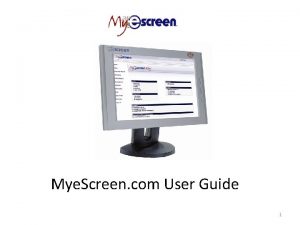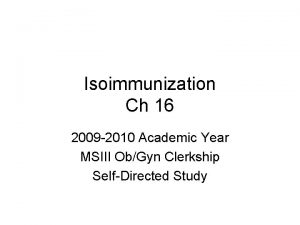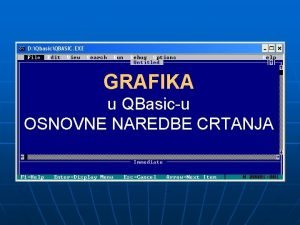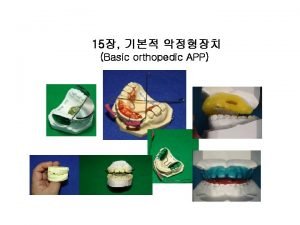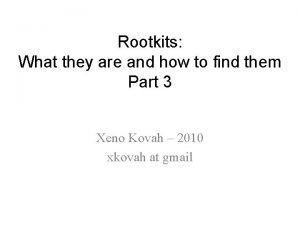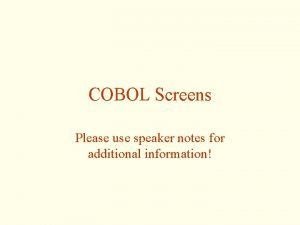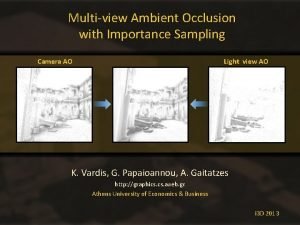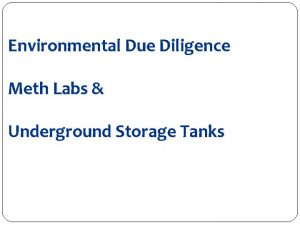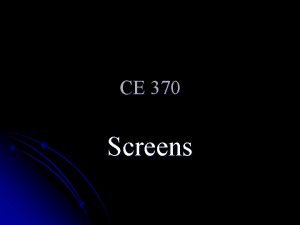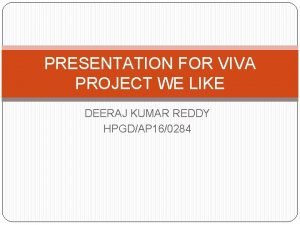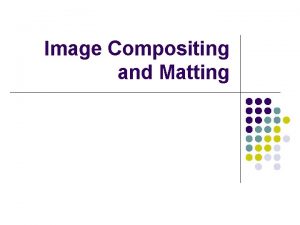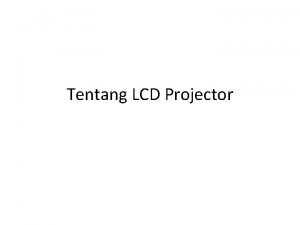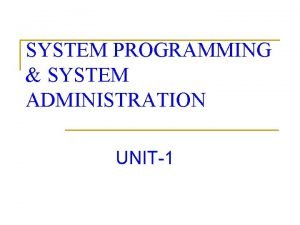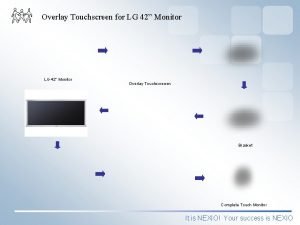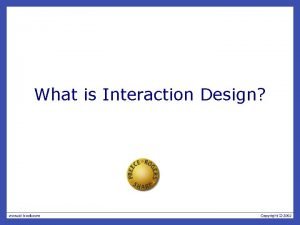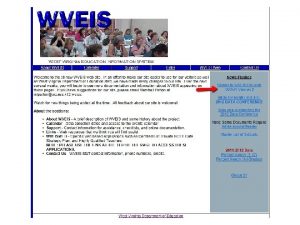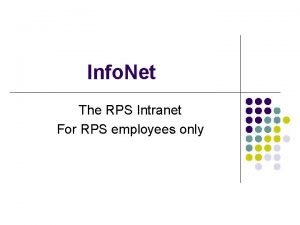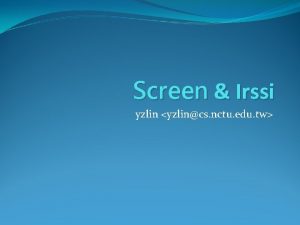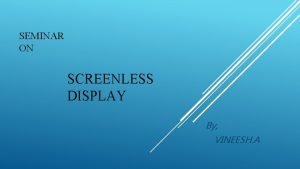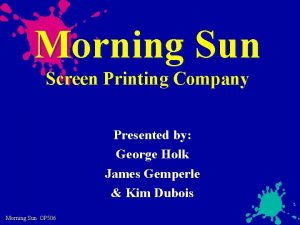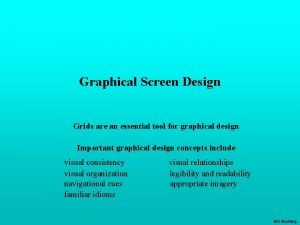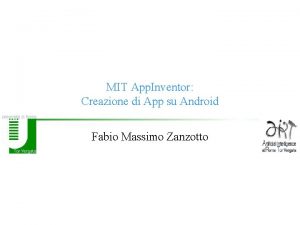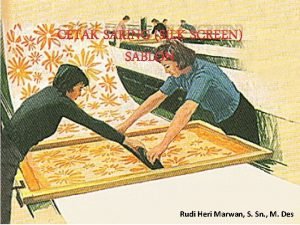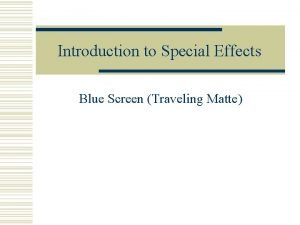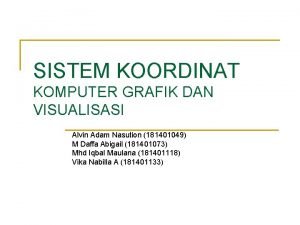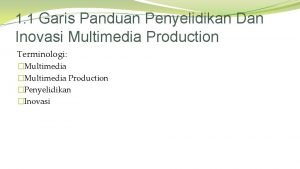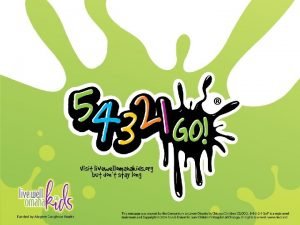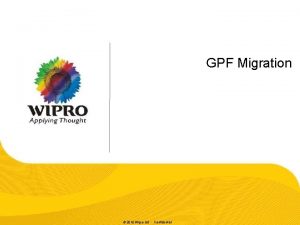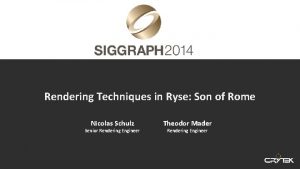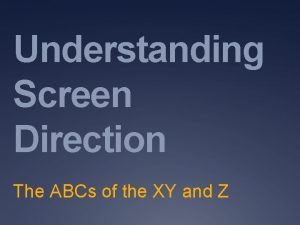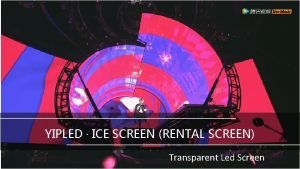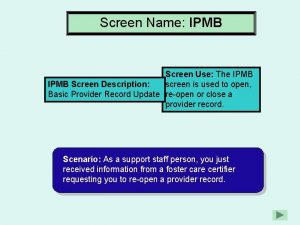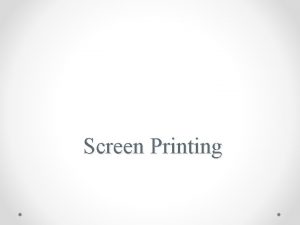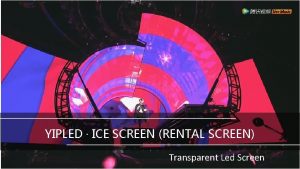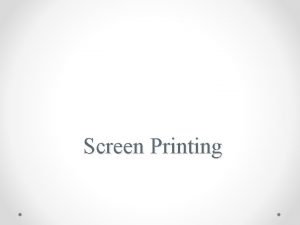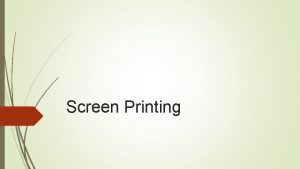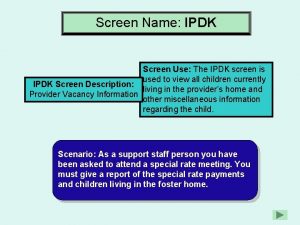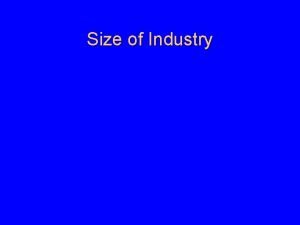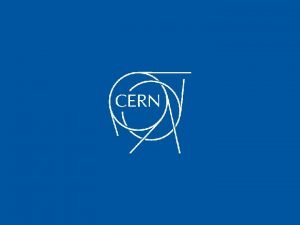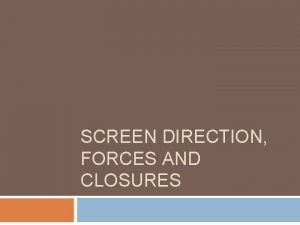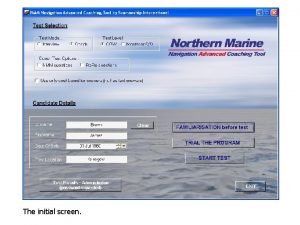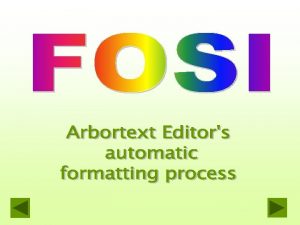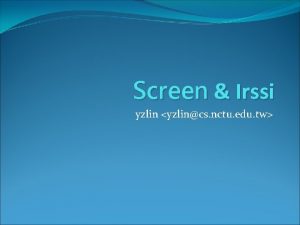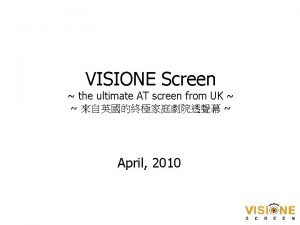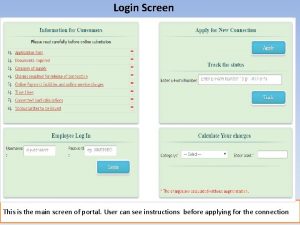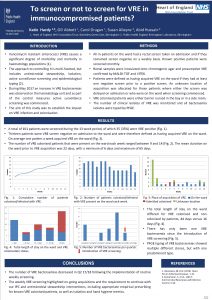screen get0 Screen Size W screen3 H screen4











![hf = figure('Color', [0, 1, 1], 'Position', [100, 200, 400, 200], . . . hf = figure('Color', [0, 1, 1], 'Position', [100, 200, 400, 200], . . .](https://slidetodoc.com/presentation_image/31fe62d2bb5f22377b9b82cb9878b41a/image-12.jpg)


![clf; set(gcf, 'Unit', 'normalized', 'Position', [0. 2, 0. 3, 0. 65, 0. 35]); set(gcf, clf; set(gcf, 'Unit', 'normalized', 'Position', [0. 2, 0. 3, 0. 65, 0. 35]); set(gcf,](https://slidetodoc.com/presentation_image/31fe62d2bb5f22377b9b82cb9878b41a/image-15.jpg)






































- Slides: 53






screen = get(0, 'Screen. Size'); W = screen(3); H = screen(4); figure('Color', [1, 1, 1], 'Position', [0. 2*H, 0. 6*W, 0. 4*H], . . . 'Name', '图形演示系统', 'Number. Title', 'off', 'Menu. Bar', 'none'); %定义Plot菜单项 hplot = uimenu(gcf, 'Label', '&Plot'); uimenu(hplot, 'Label', 'Sine Wave', 'Call', ['t=-pi: pi/20: pi; ', 'plot(t, sin(t)); ', . . . 'set(hgon, ''Enable'', ''on''); ', 'set(hgoff, ''Enable'', ''on''); ', . . . 'set(hbon, ''Enable'', ''on''); ', 'set(hboff, ''Enable'', ''on''); ']); uimenu(hplot, 'Label', 'Cosine Wave', 'Call', ['t=-pi: pi/20: pi; ', 'plot(t, cos(t)); ', . . . 'set(hgon, ''Enable'', ''on''); ', 'set(hgoff, ''Enable'', ''on''); ', . . . 'set(hbon, ''Enable'', ''on''); ', 'set(hboff, ''Enable'', ''on''); ']); %定义Option菜单项 hoption = uimenu(gcf, 'Label', '&Option'); hgon = uimenu(hoption, 'Label', '&Grig on', 'Call', 'grid on', 'Enable', 'off'); hgoff = uimenu(hoption, 'Label', '&Grig off', 'Call', 'grid off', 'Enable', 'off'); hbon = uimenu(hoption, 'Label', '&Box on', 'separator', 'on', 'Call', 'box on', 'Enable', 'off'); hboff = uimenu(hoption, 'Label', '&Box off', 'Call', 'box off', 'Enable', 'off'); hfigcor = uimenu(hoption, 'Label', '&Figure Color', 'Separator', 'on'); uimenu(hfigcor, 'Label', '&Red', 'Accelerator', 'Call', 'set(gcf, ''Color'', ''r''); uimenu(hfigcor, 'Label', '&Blue', 'Accelerator', 'b', 'Call', 'set(gcf, ''Color'', ''b''); uimenu(hfigcor, 'Label', '&Yellow', 'Call', 'set(gcf, ''Color'', ''y''); uimenu(hfigcor, 'Label', '&White', 'Call', 'set(gcf, ''Color'', ''w''); %定义Quit菜单项 uimenu(gcf, 'Label', '&Quit', 'Call', 'close(gcf)');


例5. 2 绘制曲线y=2 e-0. 5 xsin(2πx),并建立一个与之相 联系的快捷菜单,用以控制曲线的线型和曲线宽度。 x = 0: pi/100: 2*pi; y = 2*exp(-0. 5*x). *sin(2*pi*x); hl = plot(x, y); hc = uicontextmenu; %建立快捷菜单 hls = uimenu(hc, 'Label', '线型'); %建立菜单项 hlw = uimenu(hc, 'Label', '线宽'); uimenu(hls, 'Label', '虚线', 'Call', 'set(hl, ''Line. Style'', '': ''); uimenu(hls, 'Label', '实线', 'Call', 'set(hl, ''Line. Style'', ''-''); uimenu(hlw, 'Label', '加宽', 'Call', 'set(hl, ''Line. Width'', 2); '); uimenu(hlw, 'Label', '变细', 'Call', 'set(hl, ''Line. Width'', 0. 5); '); set(hl, 'UIContext. Menu', hc); %将该快捷菜单和曲线对象联系起来



![hf figureColor 0 1 1 Position 100 200 400 200 hf = figure('Color', [0, 1, 1], 'Position', [100, 200, 400, 200], . . .](https://slidetodoc.com/presentation_image/31fe62d2bb5f22377b9b82cb9878b41a/image-12.jpg)
hf = figure('Color', [0, 1, 1], 'Position', [100, 200, 400, 200], . . . 'Name', '数制转换', 'Number. Title', 'off', 'Menu. Bar', 'none'); uicontrol(hf, 'Style', 'Text', 'Units', 'normalized', 'Position', [0. 05, 0. 8, 0. 45, 0. 1], 'Horizontal', 'center', . . . 'String', '输 入 框', 'Back', [0, 1, 1]); uicontrol(hf, 'Style', 'Text', 'Position', [0. 5, 0. 8, 0. 45, 0. 1], 'Units', 'normalized', 'Horizontal', 'center', . . . 'String', '输 出 框', 'Back', [0, 1, 1]); uicontrol(hf, 'Style', 'Frame', 'Position', [0. 04, 0. 33, 0. 45], 'Units', 'normalized', 'Back', [1, 1, 0]); uicontrol(hf, 'Style', 'Text', 'Position', [0. 05, 0. 6, 0. 25, 0. 1], 'Units', 'normalized', 'Horizontal', 'center', . . . 'String', '十进制数', 'Back', [1, 1, 0]); uicontrol(hf, 'Style', 'Text', 'Position', [0. 05, 0. 4, 0. 25, 0. 1], . . . 'Units', 'normalized', 'Horizontal', 'center', 'String', '2~ 16进制', 'Back', [1, 1, 0]); he 1 = uicontrol(hf, 'Style', 'Edit', 'Position', [0. 25, 0. 6, 0. 2, 0. 1], 'Units', 'normalized', 'Back', [0, 1, 0]); he 2 = uicontrol(hf, 'Style', 'Edit', 'Position', [0. 25, 0. 4, 0. 2, 0. 1], 'Units', 'normalized', 'Back', [0, 1, 0]); uicontrol(hf, 'Style', 'Frame', 'Position', [0. 52, 0. 33, 0. 45], 'Units', 'normalized', 'Back', [1, 1, 0]); ht = uicontrol(hf, 'Style', 'Text', 'Position', [0. 6, 0. 5, 0. 3, 0. 1], . . . 'Units', 'normalized', 'Horizontal', 'center', 'Back', [0, 1, 0]); COMM = ['n=str 2 num(get(he 1, ''String'')); ', 'b=str 2 num(get(he 2, ''String'')); ', . . . 'dec=trdec(n, b); ', 'set(ht, ''string'', dec); ']; uicontrol(hf, 'Style', 'Push', 'Position', [0. 18, 0. 1, 0. 2, 0. 12], . . . 'String', '转 换', 'Units', 'normalized', 'Call', COMM); uicontrol(hf, 'Style', 'Push', 'Position', [0. 65, 0. 1, 0. 2, 0. 12], . . . 'String', '退 出', 'Units', 'normalized', 'Call', 'close(hf)');


![clf setgcf Unit normalized Position 0 2 0 3 0 65 0 35 setgcf clf; set(gcf, 'Unit', 'normalized', 'Position', [0. 2, 0. 3, 0. 65, 0. 35]); set(gcf,](https://slidetodoc.com/presentation_image/31fe62d2bb5f22377b9b82cb9878b41a/image-15.jpg)
clf; set(gcf, 'Unit', 'normalized', 'Position', [0. 2, 0. 3, 0. 65, 0. 35]); set(gcf, 'Menubar', 'none', 'Name', '图形演示', 'Number. Title', 'off'); axes('Position', [0. 05, 0. 15, 0. 55, 0. 7]); uicontrol(gcf, 'Style', 'text', 'Unit', 'normalized', . . . 'Posi', [0. 63, 0. 85, 0. 2, 0. 1], 'String', '输入绘图命令', 'Horizontal', 'center'); hedit=uicontrol(gcf, 'Style', 'edit', 'Unit', 'normalized', 'Posi', [0. 63, 0. 15, 0. 2, 0. 68], . . . 'Max', 2); %Max取 2,使Max-Min>1,从而允许多行输入 hpopup=uicontrol(gcf, 'Style', 'popup', 'Unit', 'normalized', . . . 'Posi', [0. 85, 0. 8, 0. 15], 'String', 'Spring|Summer|Autumn|Winter'); hlist=uicontrol(gcf, 'Style', 'list', 'Unit', 'normalized', . . . 'Posi', [0. 85, 0. 55, 0. 15, 0. 25], 'String', 'Grid on|Grid off|Box on|Box off'); hpush 1=uicontrol(gcf, 'Style', 'push', 'Unit', 'normalized', . . . 'Posi', [0. 85, 0. 35, 0. 15], 'String', '绘 图'); uicontrol(gcf, 'Style', 'push', 'Unit', 'normalized', . . . 'Posi', [0. 85, 0. 15, 0. 15], 'String', '关 闭', 'Call', 'close all'); set(hpush 1, 'Call', 'COMM(hedit, hpopup, hlist)'); set(hlist, 'Call', 'COMM(hedit, hpopup, hlist)'); set(hpopup, 'Call', 'COMM(hedit, hpopup, hlist)'); %COMM. m函数文件: function COMM(hedit, hpopup, hlist) com=get(hedit, 'String'); n 1=get(hpopup, 'Value'); n 2=get(hlist, 'Value'); if ~isempty(com) %编辑框输入非空时

5. 3 用户界面设计 具 (Graphical user interface development environment) reference: getstart. pdf, chapter 6, pp. 197

The Layout Editor with a blank GUI template

drag a push button into the layout area

GUI FIG-Files and M-Files GUIDE stores a GUI in two files, which are generated the first time you save or run the GUI: l A FIG-file, with extension. fig, which contains a complete description of the GUI layout and the components of the GUI: push buttons, menus, axes, and so on. l A M-file, with extension. m, that contains the code that controls the GUI, including the callbacks for its components. These two files correspond to the tasks of laying out and programming the GUI. When you lay out of the GUI in the Layout Editor, your work is stored in the FIG-file. When you program the GUI, your work is stored in the M-file

Creating Graphical User Interfaces • Designing the GUI • • Laying Out the GUI Setting Properties for GUI Components Programming the GUI Saving and Running a GUI

Designing the GUI üAn axes that displays plot of the data üThree push buttons that enable you to select the type of plot you want. üThe pop-up menu contains three strings -- peaks, membrane, and sinc, which correspond to MATLAB functions. You can select the data to plot from this menu.

Laying Out the GUI Ø Open a New GUI in the Layout Editor Ø Set the GUI Figure Size. Ø Add the Components Ø Align the Components.

>> guide

Select the Blank GUI (default) template. Click OK

若要显示组件面板(component palette)的GUI组件的 名称, 选择 File → Preferences→ Show names in component palette

Set the GUI Figure Size

l If you want to set the position or size of the GUI to an exact value: 1. Select Property Inspector from the View menu. 2. Select the button next to Units and then select inches from the pop-up menu 3. Click the + sign next to Position. 4. Type the x and y coordinates of the point where you want the lower left corner of the GUI to appear, and its width and height, as shown in the following figure. 5. Reset the Units property to characters.


Add the Components 1. Add the panel and push buttons to the GUI.

Add the remaining components to the GUI: a static text , a pop-up menu, an axes

Align the Components Alignment Tool : 将有同一父代的组件对齐 如:将上面的三个push buttons对齐 1. pressing Ctrl and clicking them. 2. Tools menu → Align Objects , 出现 Alignment Object. 3. 本例中采用如下设置: ü 20 pixels spacing between push buttons in the vertical direction. ü Left-aligned in the horizontal direction.


Setting Properties for GUI Components View →Property Inspector from the menu to display the Property Inspector dialog box l l l Name Property Title Property String Property for Push Buttons and Static Text String Property for Pop-Up Menus Callback Properties The Tag Property

l Name Property

l Title Property l String Property for Push Buttons and Static Text

l String Property for Pop-up Menus

the current layout of the GUI appears as :

l Callback Properties Components use callbacks to do their work. Each component and menu item has properties that specify its callbacks. When you create a GUI, you must program the callbacks you need to control operation of the GUI l The Tag Property The Tag property provides a string as a unique identifier for each component. GUIDE uses this identifier to construct unique callback names for the different components in the GUI

When you save or run the GUI, GUIDE sets the name of the callback subfunction in the pop-up menu Callback property to plot_popup_Callback.

Programming the GUI • • • Creating the GUI M-File Opening the GUI M-File Sharing Data Between Callbacks Adding Code to the Opening Function Adding Code to the Callbacks Using the Object Browser to Identify Callbacks

Opening the GUI M-File üAdd code to the callbacks for the three push buttons and the pop-up menu. üopen the created M-file by clicking the M-file Editor icon on the toolbar. In the editor, move the cursor to a specific callback by clicking the function icon on the toolbar, then selecting the callback you want in the pop-up menu that displays.



Sharing Data Between Callbacks Ø Storing the data in the MATLAB handles structure. All components in a GUI share the same handles structure. Eg. Store vector X in the handles structure: 1. Choose a name for the field of the handles structure where you want to store the data, for example, handles. my_data 2. Add the field to the handles structure: handles. my_data = X; 3. Save the handles structure with the guidata function: guidata(h. Object, handles) h. Object is the handle to the component object that executes the callback. Ø h. Object and handles are input arguments for all the callbacks generated by GUIDE

Adding Code to the Opening Function Ø The Opening Function: is the first callback in every GUI M-file. ØName: GUI M-文件的名字_Opening. Fcn,例如: simple_gui_Opening. Fcn ØEg. Add code that creates three data sets in the opening function, using peaks, membrane, and sinc.

% --- Executes just before simple_gui is made visible. function simple_gui_Opening. Fcn(h. Object, eventdata, handles, varargin) % This function has no output args, see Output. Fcn. % h. Object handle to figure % eventdata reserved - to be defined in a future version of MATLAB % handles structure with handles and user data (see GUIDATA) % varargin command line arguments to untitled (see VARARGIN) Autogenerated code % Create the data to plot handles. peaks=peaks(35); handles. membrane=membrane; Add this code [x, y] = meshgrid(-8: . 5: 8); r = sqrt(x. ^2+y. ^2) + eps; sinc = sin(r). /r; handles. sinc = sinc; handles. current_data = handles. peaks; surf(handles. current_data)


Adding Code to the Callbacks Push Button Callbacks

Push Button Callbacks % --- Executes on button press in surf_pushbutton. function surf_pushbutton_Callback(h. Object, eventdata, handles) % h. Object handle to surf_pushbutton (see GCBO) % eventdata reserved - to be defined in a future version of MATLAB % handles structure with handles and user data (see GUIDATA) % Display surf plot of the currently selected data surf(handles. current_data); Autogenerated code Add this code

Add this code to the Mesh push button callback: % Display mesh plot of the currently selected data mesh(handles. current_data); Add this code to the Contour push button callback: % Display contour plot of the currently selected data contour(handles. current_data);

Pop-up Menu Callback % --- Executes on selection change in plot_popup. function plot_popup_Callback(h. Object, eventdata, handles) % h. Object handle to plot_popup (see GCBO) % eventdata reserved - to be defined in a future version of MATLAB % handles structure with handles and user data (see GUIDATA) val = get(h. Object, 'Value'); str = get(h. Object, 'String'); switch str{val}; Add this code case 'peaks' % User selects peaks handles. current_data = handles. peaks; case 'membrane' % User selects membrane handles. current_data = handles. membrane; case 'sinc' % User selects sinc handles. current_data = handles. sinc; end guidata(h. Object, handles) Autogenerated code

Using the Object Browser to Identify Callbacks Ø In a complicated GUI, keeping track of callbacks can be difficult. To identify the component corresponding to a callback, select Object Browser from the View menu. Ø The Object Browser lists the tag and string properties of each component of the GUI.

Using the Object Browser to Identify Callbacks
 Screen small screen offscreen
Screen small screen offscreen![Const int size=18; string *tb12 = new string[size]; Const int size=18; string *tb12 = new string[size];](data:image/svg+xml,%3Csvg%20xmlns=%22http://www.w3.org/2000/svg%22%20viewBox=%220%200%20200%20200%22%3E%3C/svg%3E) Const int size=18; string *tb12 = new string[size];
Const int size=18; string *tb12 = new string[size]; Size separation objectives
Size separation objectives Intel integrator toolkit
Intel integrator toolkit My escreen
My escreen First screen feasibility analysis
First screen feasibility analysis Tanabe folder gluer
Tanabe folder gluer Antibody screen
Antibody screen Screen 12 qbasic
Screen 12 qbasic Ethical principles screen
Ethical principles screen Oral screen
Oral screen Malleleous
Malleleous Successmaker login screen
Successmaker login screen Hxdef100.exe
Hxdef100.exe Unity animator class
Unity animator class Cobol screen section
Cobol screen section Screen transition
Screen transition Welcomeclient login screen
Welcomeclient login screen Screen space ao
Screen space ao Astm e1528 14 transaction screen questionnaire
Astm e1528 14 transaction screen questionnaire Head loss through bar screen
Head loss through bar screen Nasw essential steps for ethical problem solving
Nasw essential steps for ethical problem solving Viva project cards
Viva project cards Blue screen matting
Blue screen matting Quick mild cognitive impairment screen
Quick mild cognitive impairment screen Ukuran screen projector
Ukuran screen projector Debug monitor in system programming
Debug monitor in system programming How do these screen objects afford
How do these screen objects afford Dolgoff ethical principles screen
Dolgoff ethical principles screen Nexio touch screen
Nexio touch screen Screen truepress 344
Screen truepress 344 7 parts of a cell
7 parts of a cell Agavibe
Agavibe Screen ratio
Screen ratio Led screen rental manchester
Led screen rental manchester Interaction design
Interaction design Wow change login screen
Wow change login screen Rps intranet
Rps intranet Irssi screen
Irssi screen Screen less display ppt
Screen less display ppt Dubois screen printing
Dubois screen printing Graphical screen design
Graphical screen design App inventor screen orientation
App inventor screen orientation Bahan cetak saring
Bahan cetak saring Freud theory
Freud theory Traveling matte
Traveling matte Electroluminescent watch
Electroluminescent watch Coordinate system in computer graphics
Coordinate system in computer graphics Green screen garis lurus
Green screen garis lurus Screen time advantages
Screen time advantages Principle of input design
Principle of input design Vd screen wipro
Vd screen wipro Ryse son of rome screen adjust
Ryse son of rome screen adjust What is screen direction
What is screen direction

![Const int size=18; string *tb12 = new string[size]; Const int size=18; string *tb12 = new string[size];](https://slidetodoc.com/wp-content/uploads/2020/11/1588947_40cf3415d0afabae1c436a49b39f4ad0-300x225.jpg)


